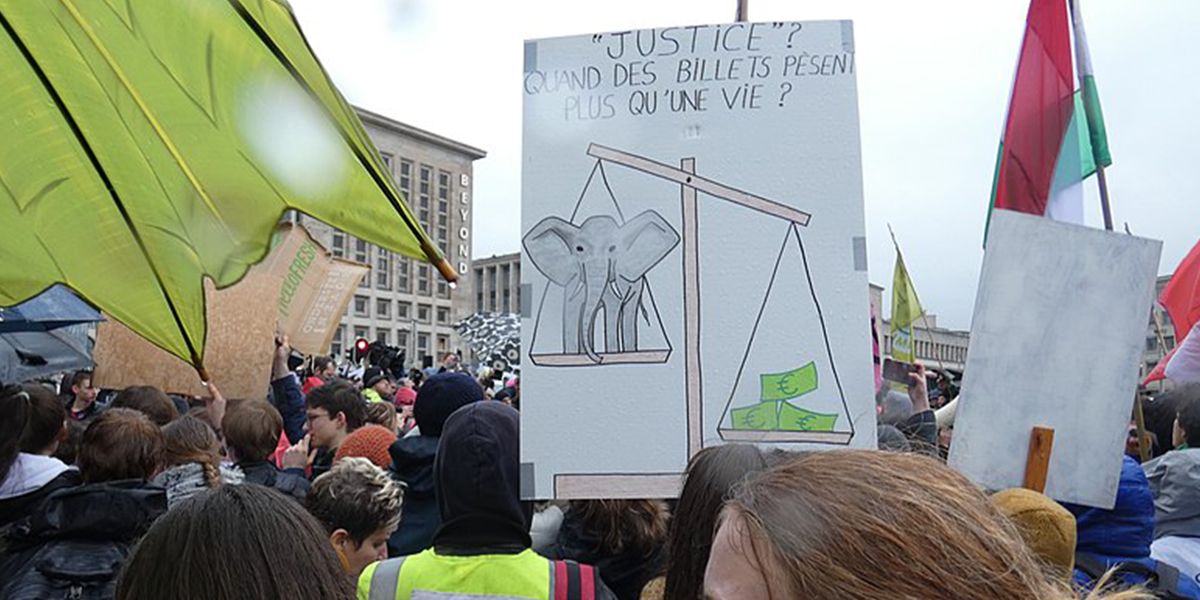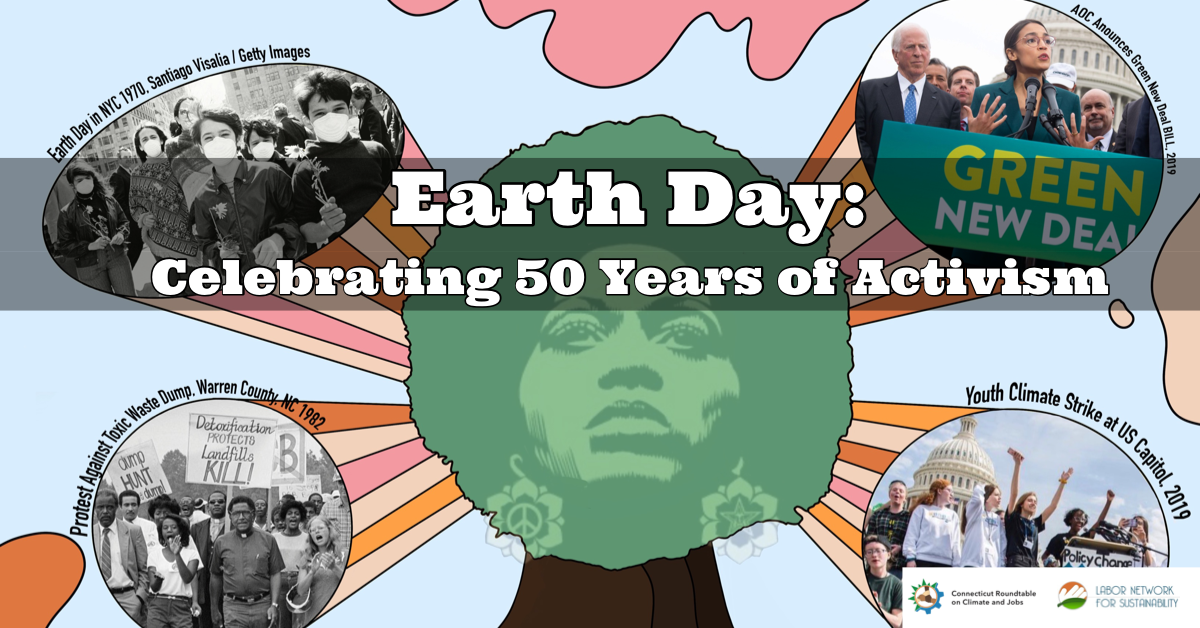When young people around the world began their Climate Strikes, organized workers began joining in, contributing to the September 20, 2019 tally of more than seven million participants worldwide. Many unions were poised to help make the 2020 Earth Week climate strikes still bigger—when the coronavirus pandemic intervened. But trade unionists and other climate protectors are saving Earth Week by taking it on-line.

Brussels School Strike for Climate 2020-03-06, attended by Greta Thunberg. Photo Credit: Wikimedia Commons
While today unions are struggling to protect the lives and livelihoods of their members from the coronavirus, many are still planning to participate in the Earth Week Strike for Climate – now gone digital.[1] In honor of their commitment, we present what may be the first history of labor’s little-known role in the global climate strikes. This commentary is part of an ongoing series on the Future of Climate Strikes.
In August, 2018 a young girl skipped school and sat alone in front of the Swedish parliament holding a sign that said “Student Strike for Climate.” Soon students around the world were joining her weekly climate strike. Then organized workers in many countries joined the actions. For example, the French Democratic Confederation of Labor (CFDT) called for every member to participate in the March 15, 2019 climate strike.[2] According to the International Trade Union Confederation, which represents 207 million workers in 163 countries, unions in Australia, Belgium, France, Italy, the UK and elsewhere took part in the climate strikes and many others were active in mobilizing their members.[3]
The most dramatic conjunction of students and workers occurred in Belgium. On December 2, 2018, sixty-five thousand Belgians had demonstrated to demand the government take action on climate. On December 29 two Belgian girls, inspired by Greta Thunberg, announced a school strike for climate. Two weeks later three thousand striking students marched through the streets of Brussels. Meanwhile, Belgian unions had launched a “Fight for E14” campaign, (modeled on the American “Fight for $15”) against government wage restrictions. On February 13, 2019 a general strike forced the government to rescind the restrictions.
According to one Belgian activist,
Early in the morning of the general strike, students entering their sixth week of school strikes visited the picket lines to express their solidarity. The day after that, a new group of trade unionists and working Belgians called “Workers For the Climate” showed up to support at least fifteen thousand youngsters in a fresh march through the streets of Brussels, while many thousands more showed up at protests around the country.[4]
On March 15 in the Belgian cities of Antwerp, Bruges, Liege, and Brussels blue- and white collar-workers across the Flemish-Francophone linguistic divide and from rival unions joined the student strike. The spokesperson for one large trade union said, “This is the first time we have had a political strike together with young people. Maybe we’re at the beginning of a new era. I hope so. Everyone talks about the climate now. Everyone is aware of it, thanks to the students.”[5]
U.S. Workers Join the Climate Strikes
While organized labor in the US had long been divided on climate issues, a wide array of unions and other labor organizations participated in the September 2019 climate strike.[6]
In August, 2019 the Labor Network for Sustainability published A Climate Strike Toolkit for Workers: How to Support the Young People Who Are Striking to Save Our Planet.[7] Starting on August 26 2019 LNS, in cooperation with 350.org, began hosting a biweekly Climate Strike Labor Table videoconference to encourage unions and other labor organizations to support and participate in the Climate Strike and to coordinate their efforts to do so. The calls involved regular reports on organizing efforts and strike support by more than a dozen unions and allied organizations. The calls played a significant role in encouraging unions to participate and gain information and inspiration from each other about how to do so. The calls continued beyond the week of the strike for evaluation and future planning.
The following unions supported the youth climate strikes:
- 1199 SEIU
- 1199 SEIU UHWE
- AFSCME DC 37
- AFSCME Local 3299
- Alameda Labor Council
- American Federation of Teachers
- AFT Guild, Local 1931
- California Federation of Teachers
- Massachusetts Teachers Association
- New York State Nurses Association
- NYC LCLAA
- PSC CUNY
- Rutgers AAUP-AFT
- SEIU
- SEIU 32 BJ
- SEIU 1021
- UAW Local 2865
- UAW Local 5810
- UE
- UFCW Local 888
- UPTE/CWA Local 9119
The Service Employees International Union (SEIU) called on its local unions to participate in the Climate Strike as part of its support for the Green New Deal. SEIU local unions and their partner organization Fight for $15 participated in 16 cities – New York, Boston, Washington DC, San Juan, Detroit, Tampa, Cincinnati, Kansas City, Chicago, Minneapolis, Denver, St Louis, Columbus, Seattle, Portland and San Francisco.
SEIU locals turned out members, provided financial support to student organizations, and supported logistics and social media for the strike. Nationally, SEIU promoted the strike through a multi-day social media campaign including a solidarity video with president Mary Kay Henry. SEIU Local 1 member leader and veteran school janitor Erica Sanchez told a Chicago rally,
It’s the youth who are leading the way. For months, young people have been going on strike to demand climate action. And today, adults are joining them to build a multigenerational movement. I’m here not just for myself but for my daughter. She must be able to live in a safe, healthy world. Any further delay will deny our generation and future generations a livable, just future.
American Federation of Teachers (AFT) locals and members participated in the strikes in New York City, New Jersey, Washington, DC, San Francisco, and many other locations around the country. AFT President Randi Weingarten, who marched in New York with AFT members from the United Federation of Teachers (New York City public schools), the Professional Staff Congress (City University of New York), and United University Professions (State University of New York), sent a message to AFT members: “From students walking out in solidarity against gun violence, to young people marching for action on climate change across the world, we see powerful examples of what happens when young people take action for change.”[8] The AFT local at Rutgers University along with other trade unionists, students, and community members organized a Central Jersey Climate Coalition that demanded Rutgers become carbon-neutral by 2030 – whereupon the president of the university appointed a committee to make a plan to be carbon-neutral by 2030, chaired by a public advocate of such a plan. The national AFT formed a climate working group.
The Massachusetts Teachers Association, associated with the National Education Association and the largest union in Massachusetts, passed a resolution supporting a strike for the Green New Deal and encouraging the National Education Association to do the same. It supported the student strike, recruited teachers to work with student strike groups, organized buses for high school and college students to attend strike events, and helped distribute a student-produced Teacher Toolkit for the strike.[9]
Communications Workers of America (CWA) members from a variety of locals and districts joined the climate strike. District 9 Vice President Frank Arce wrote member locals describing:
Massive wildfires, category 5 hurricanes, years long drought and unprecedented flooding, sea level rise, heat waves and crop failures, all exacerbated by the human created climate breakdown. This is a critical moment in human history. Global fossil fuel emissions from our use of oil, coal, and gas are still going up, driving our climate crisis further towards catastrophe. All around the world youth have been going on school strike to demand urgent climate action to protect their health, safety, lives and futures. Collective action and power may be our last and best chance.”[10]
Lead Activist Amanda Bratcher of CWA’s youth program America’s Next Generation said,
We’re proud to support the climate strikes. It’s way past time for us to demand genuine solutions to a crisis that’s already wreaking havoc for so many people around the world, whether it’s in the form of extreme weather such as Hurricane Dorian or increased risk to workers from heat-related illnesses or critically endangered infrastructure in our communities.
Unions also joined forces to promote local labor action in major cities. In the San Francisco Bay area, for example, 200 union members marched in the Labor Contingent for three miles through downtown San Francisco. along with 40,000 other participants. Workers demanded that world leaders take immediate, bold action on climate change and to raise standards for working people. Spirited chants included “Green New Deal, Make it Real! Just Transition, That’s our Mission!” and “One Job Should Be Enough, One Planet is All We Have.” Union members joined other Bay Area actions in Berkeley, Santa Rosa, Chico, and Sacramento.
Three California central labor councils endorsed and turned out for the strike: San Francisco Labor Council, Alameda Central Labor Council, and Contra Costa Labor Council. Twenty-four unions participated in the labor contingent.[11] Other actions with labor participation included a painting of street murals in the San Francisco financial district and an oil company blockade. Labor participation was mobilized by Labor Rise for Climate, Jobs, Justice, & Peace, an affiliate of the Labor Network for Sustainability. In New York at least ten unions officially endorsed the climate strikes.[12]
Workers and the Future of the Climate Strikes

Graphic: Taylor Mayes, Connecticut Roundtable on Climate and Jobs
Few if any workers in the US represented by unions and working under union contracts actually struck (quit working to shut down their employers). The largest actual walkout was by Amazon workers, who are not represented by a union. Even the radical UE union in its resolution endorsing the student strike said it encouraged UE members to find creative ways to participate “without violating collective bargaining agreements if applicable.”[13]
Could the September 2019 climate strike nonetheless be a harbinger of global mass strikes to impose protection of the climate? Organizing to promote that possibility began immediately after September 20. Youth around the world planned to continue the weekly Friday school strikes for climate they had been conducting over the previous year. And they began laying plans to make the week of April 22, 2020 — the fiftieth anniversary of the first Earth Day — a global climate strike on a truly historic scale. The youth Sunrise Movement, which initiated the drive for a Green New Deal, called for “mass strikes” that use mass direct action to go beyond one-day protest events. It began encouraging people to form “Strike Circles” of 7-20 young people who gather weekly to organize for climate strikes in schools, neighborhoods, towns – and workplaces.
The coronavirus pandemic changed everything, including, of course, the climate strikes. When the pandemic struck, the climate strikers responded by reprograming their actions into a three-day on-line Earth Day Live extravaganza with hundreds of affiliated local hubs.[14] The programming will include specific segments amplifying the concerns and contributions of workers and unions.
While few things in the coronavirus era are certain, the climate strikes are continuing, and workers are likely to continue playing a role in them. Climate destruction represents an existential threat to all workers, as well as to the rest of humanity. When workers strike they have a special power – indeed, they can potentially bring the most powerful forces in society to their knees. Could workers strike to protect the climate? Many workers around the world are already supporting the student climate strikes. Whether they can overcome the barriers to actually striking to save the climate will be up to them. In the meantime, they will have helped preserve the momentum of the movement despite the monumental interference of the coronavirus pandemic.
[1] “Earth Day to May Day 2020,” https://www.labor4sustainability.org/articles/earth-day-to-may-day-2020/ and “Organizing Toolkit: Earth Day Labor Actions and Climate Strikes” https://www.labor4sustainability.org/organizing-toolkit-2020/
[2] “Climate strikes held around the world – as it happened.” https://www.theguardian.com/environment/live/2019/mar/15/climate-strikes-2019-live-latest-climate-change-global-warming
[3] ITUC, “Students strike now for the jobs of tomorrow,” https://www.ituc-csi.org/Fridays4Future-Worldwide-15March
[4] Jos D’Haese, “Belgium’s Hottest Winter,” Jacobin, March 11, 2019. https://jacobinmag.com/2019/03/belgium-students-strike-climate-global-warming
[5] “Climate strikes held around the world – as it happened.” The Guardian, March 15, 2019. https://www.theguardian.com/environment/live/2019/mar/15/climate-strikes-2019-live-latest-climate-change-global-warming
[6] For a review of US labor participation in the September 20-27 climate strike, including sources for information in this section not otherwise identified, see the Labor Network for Sustainability newsletter Making a Living on a Living Planet #33 September, 2019 https://labor4sustainability.ourpowerbase.net/civicrm/mailing/view?reset=1&id=365 and #34 October, 2019 https://labor4sustainability.ourpowerbase.net/civicrm/mailing/view?reset=1&id=370
[7] A Climate Strike Toolkit for Workers, Labor Network for Sustainability, August 2019. https://www.labor4sustainability.org/wp-content/uploads/2019/07/ClimateStrike.pdf
[8] AFT News ˆGlobal Climate Strike demonstrates mass movement to address climate change, :
https://www.aft.org/news/global-climate-strike-demonstrates-mass-movement-address-climate-change
[9] Teacher Toolkit, Boston Climate Strike. https://docs.google.com/document/d/1Yv6vp_PvUIfvhpy8P7qpEf7WJkIXO-5YYbSkb0nR3ss/edit#heading=h.zcgkg3oimul0
[10] https://district9.cwa-union.org/news/cwaers-walkout-in-support-of-climate-strike
[11] Unions participating included CWA, CNA, Peralta Federation of Teachers, SEIU 1021 and 2015, United Educators San Francisco, Oakland Education Association, Unite Here Local 2, IFPTE L21 and 20, Sheet Metal Workers, ILWU, IWW, Inland Boatman Union, AFSCME 3299, UAW 5810/2865, California Faculty Association, BFT, Sierra Club Union, Jobs with Justice, Carpenter 2236, Teamsters, and AFGE.
[12] Unions officially endorsing the strike included 1199, Service Employees International Union, American Federation of State, County and Municipal Employees, DC37, Communication Workers of America, International Brotherhood of Teamsters Joint Council 16, New York City Labor Council For Latin American Advancement, New York State Nurses Alliance, Professional Staff Congress/City University of New York, Service Employees International Union 32BJ, United Federation of Teachers, and United Food and Commercial Workers Local 888. Unions particularly active in turning out members included AFSCME District Council 37, New York State Nurses Alliance, City University of New York PSC, and SEIU 1199.
[13] UE, “A Green New Deal for People and Planet,” https://www.ueunion.org/ue-policy/a-green-new-deal-for-people-and-the-planet
[14] “Earth Day Live,” https://www.earthdaylive2020.org


